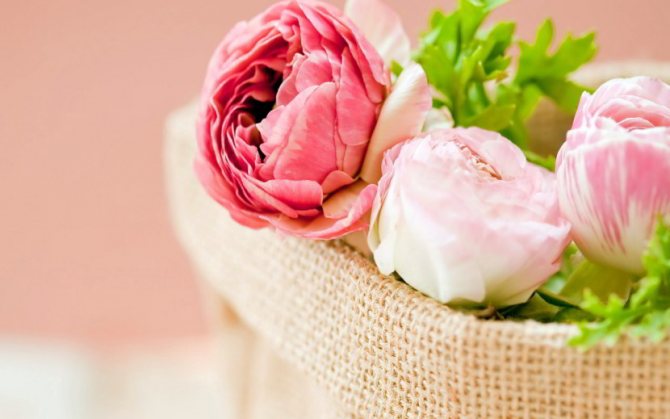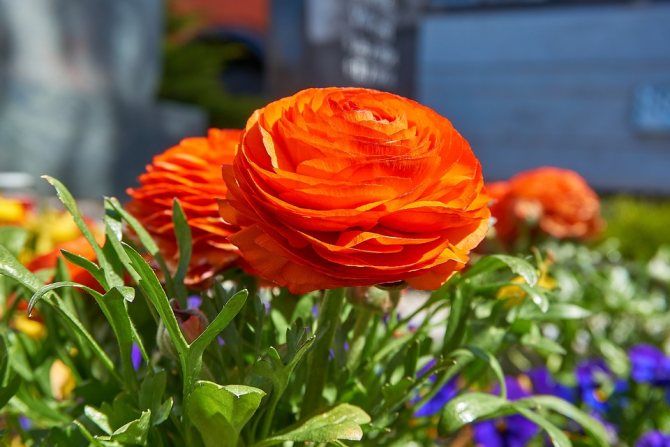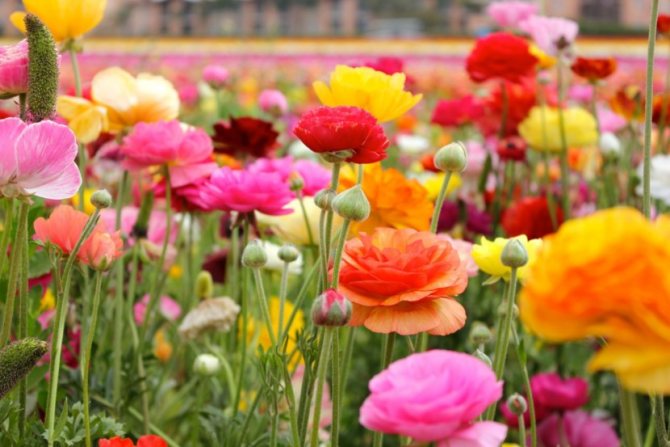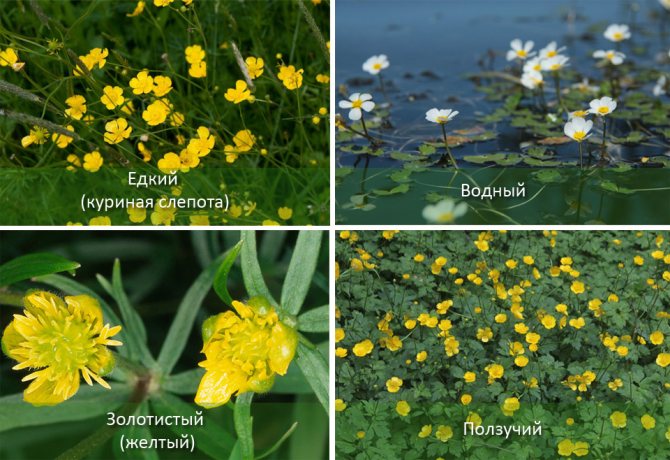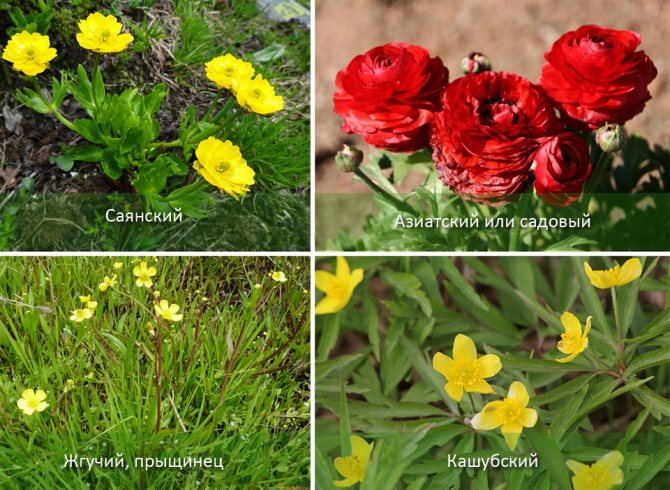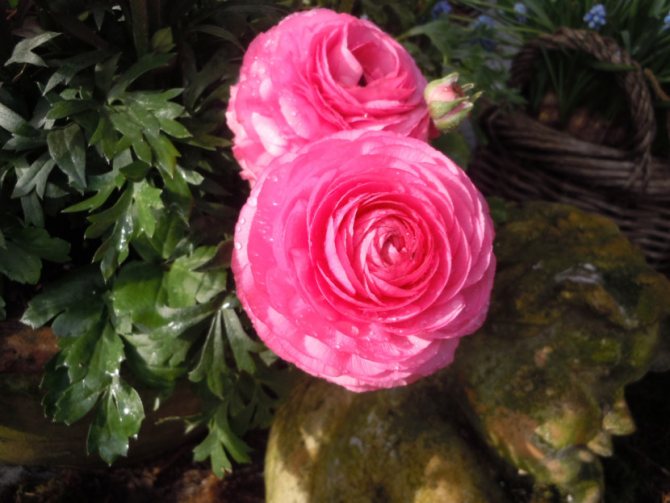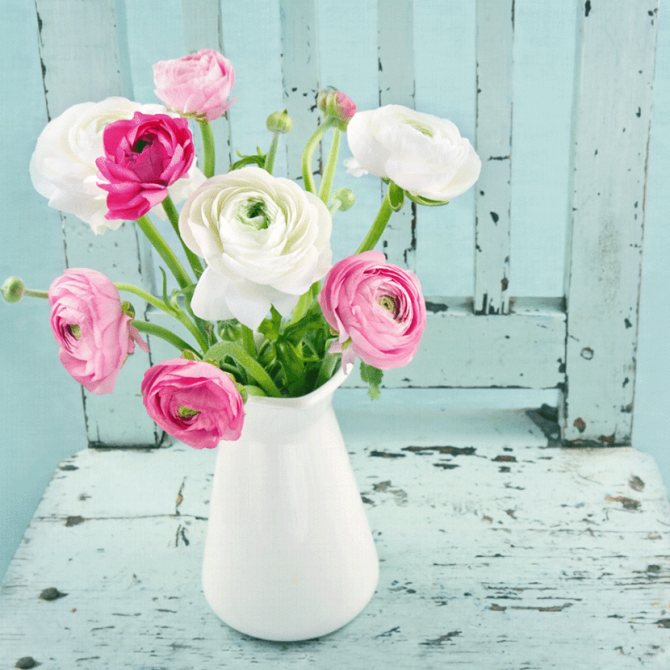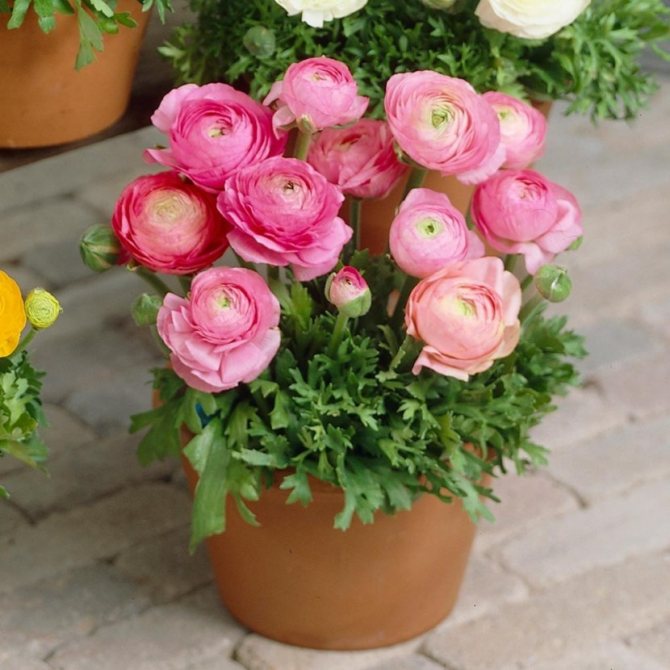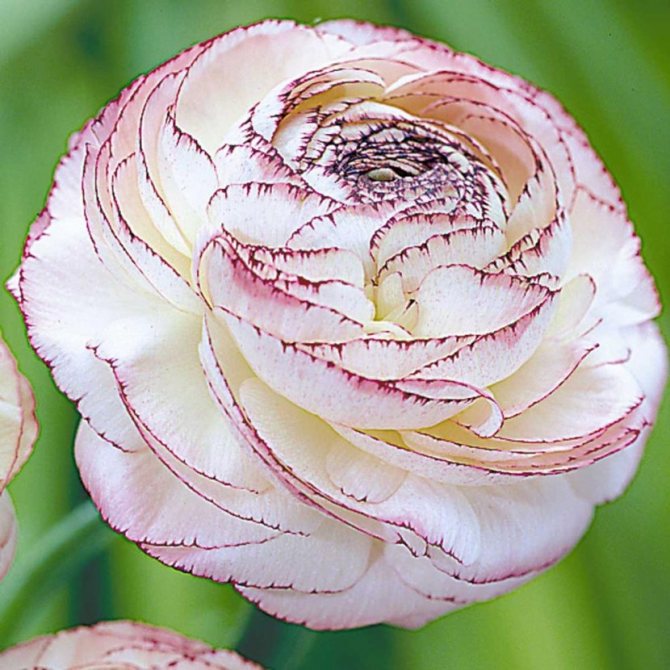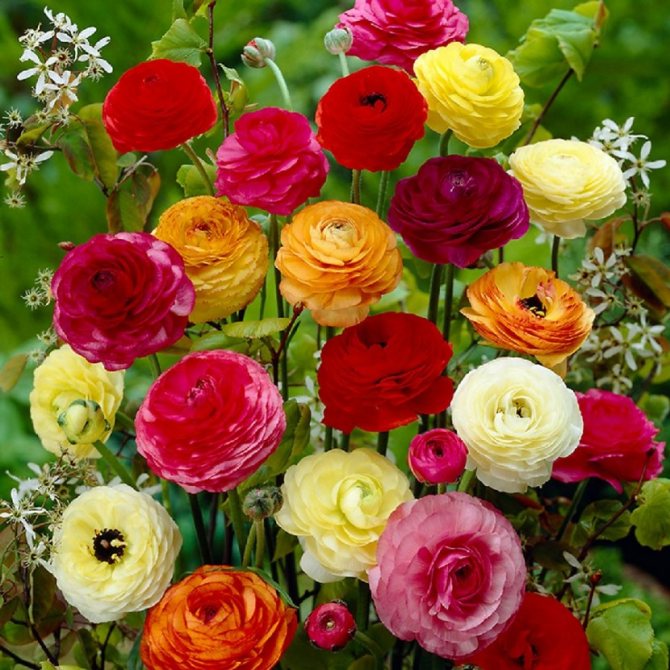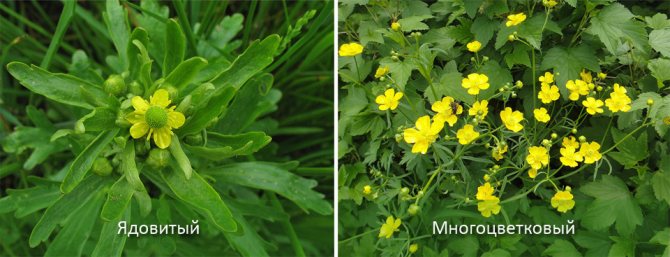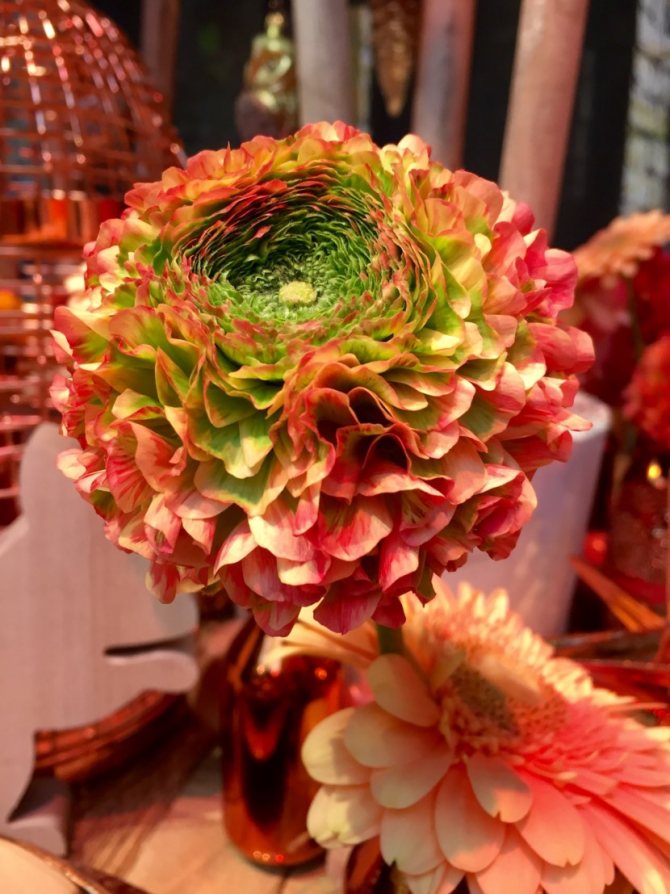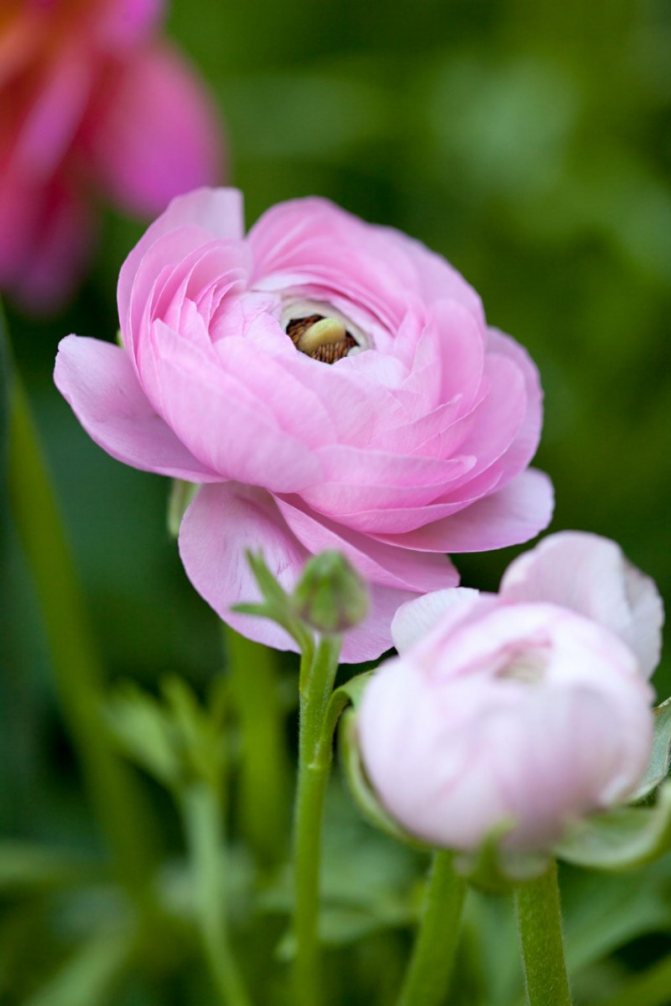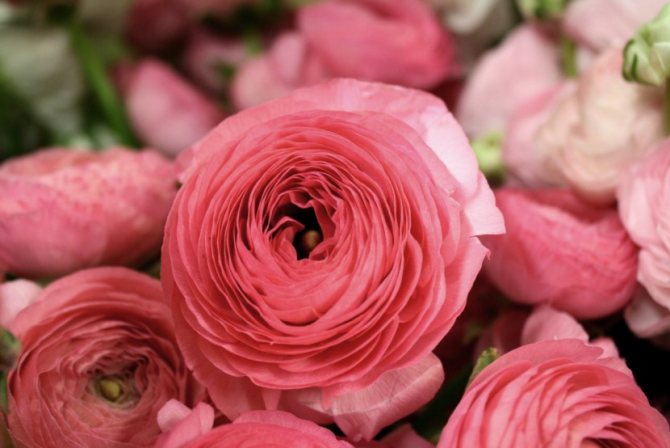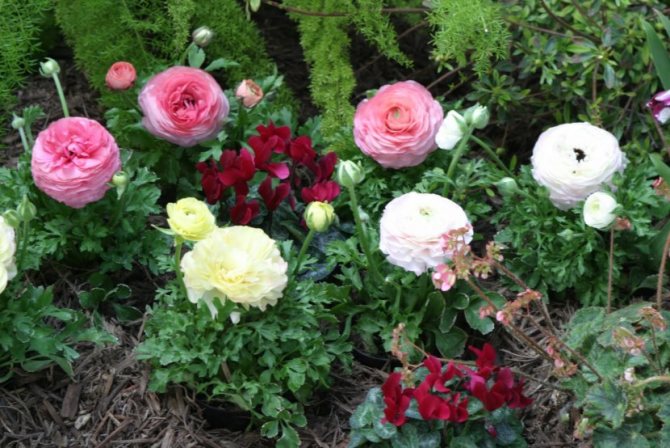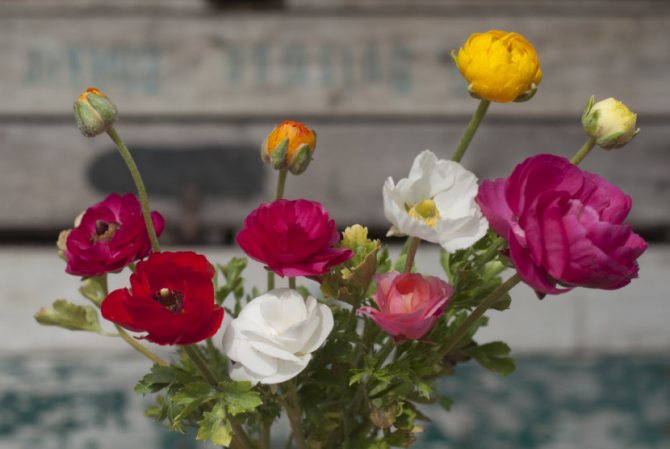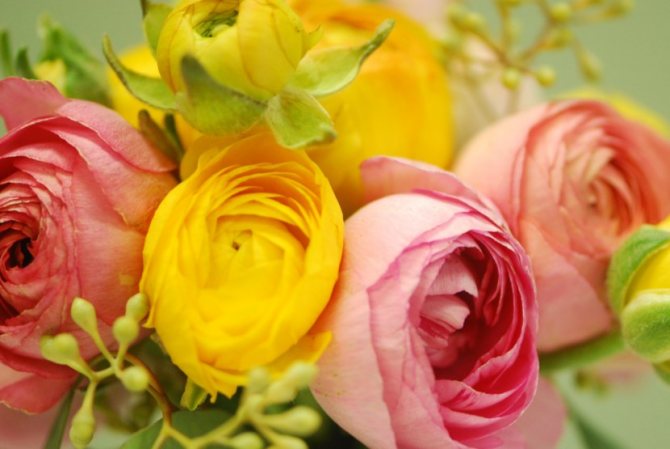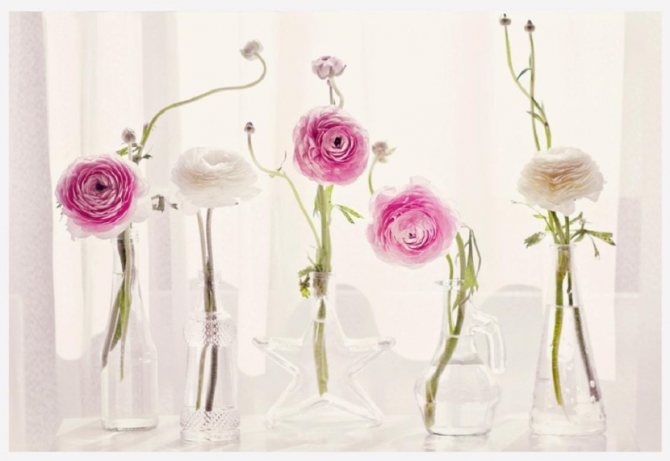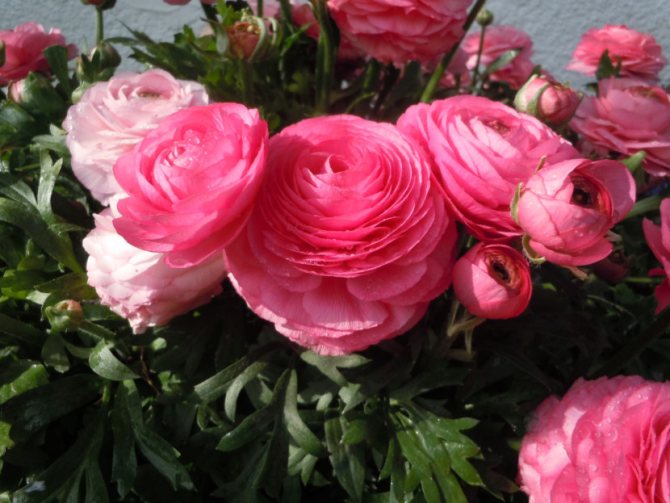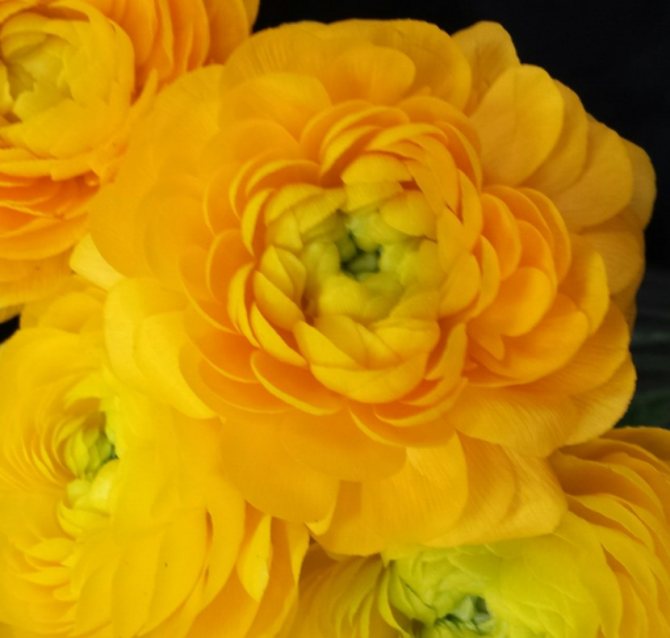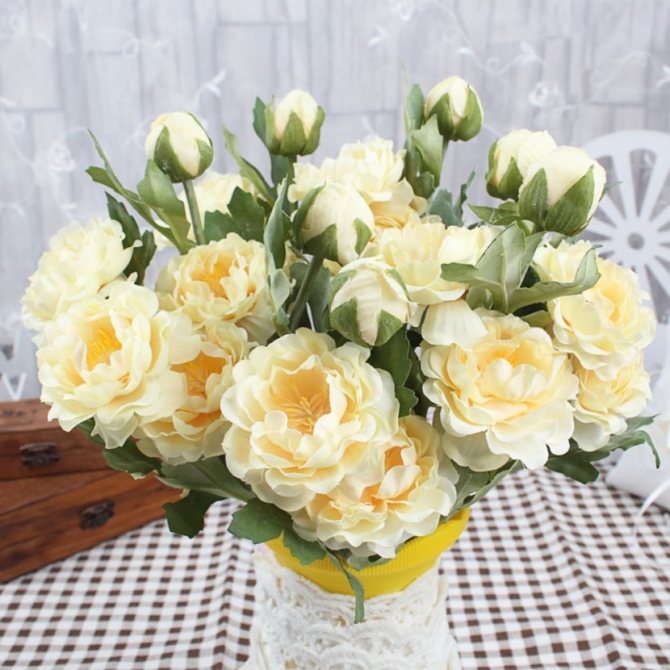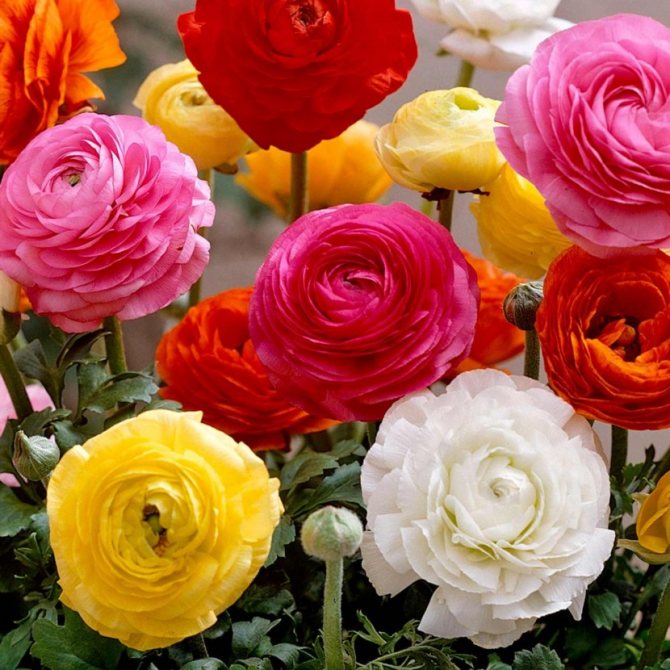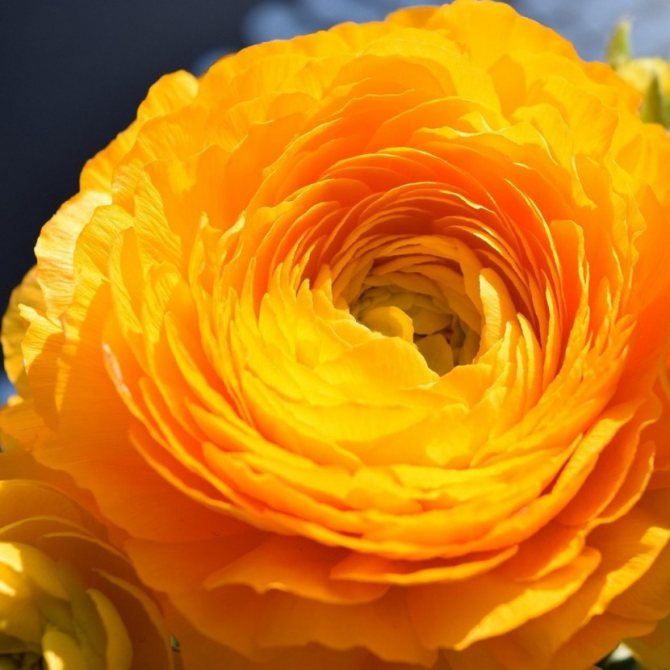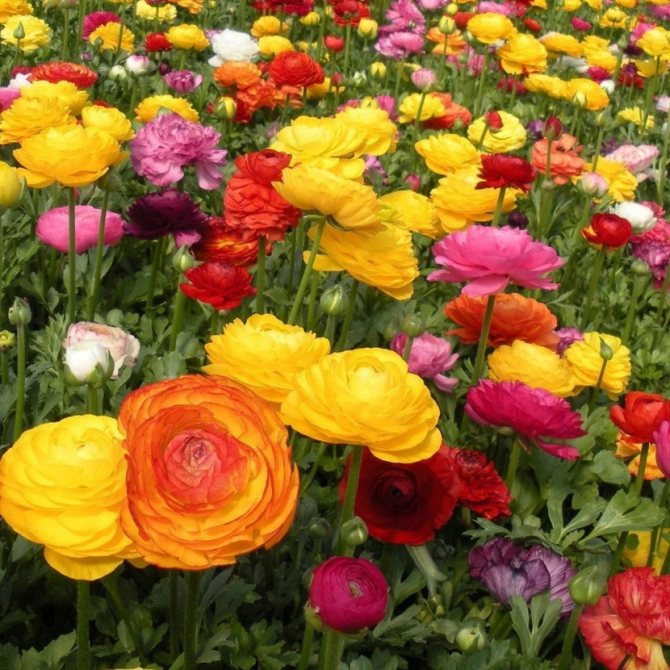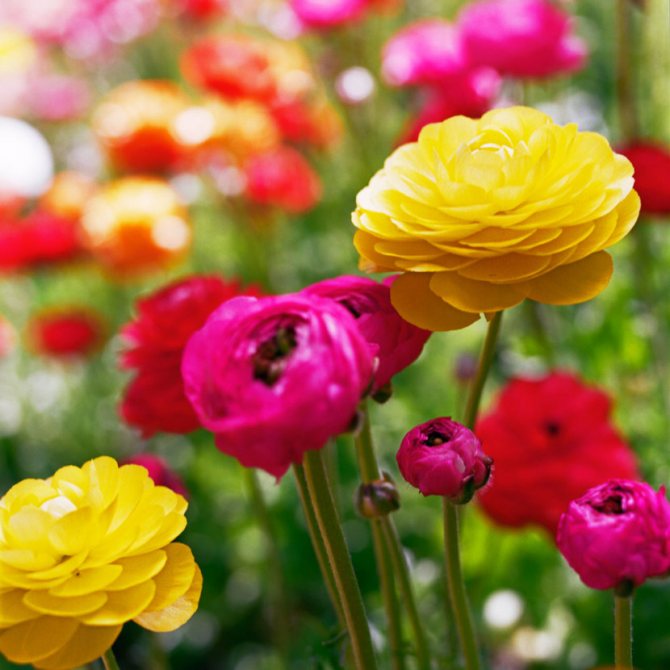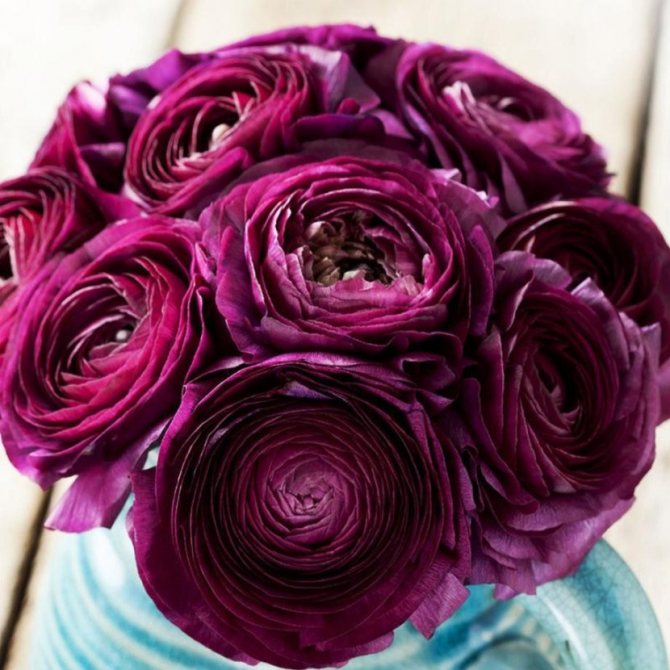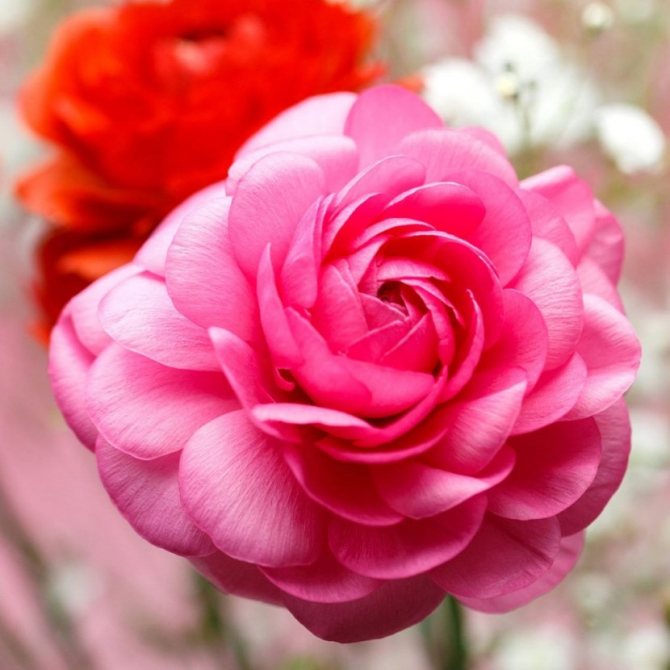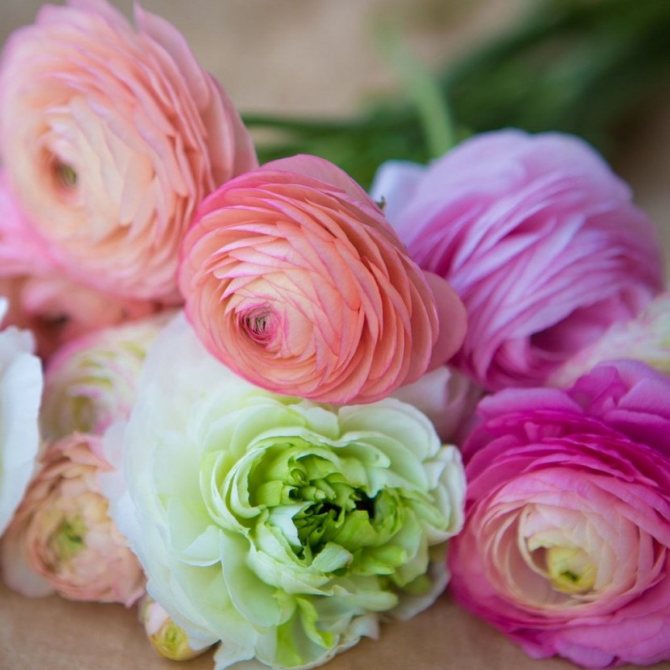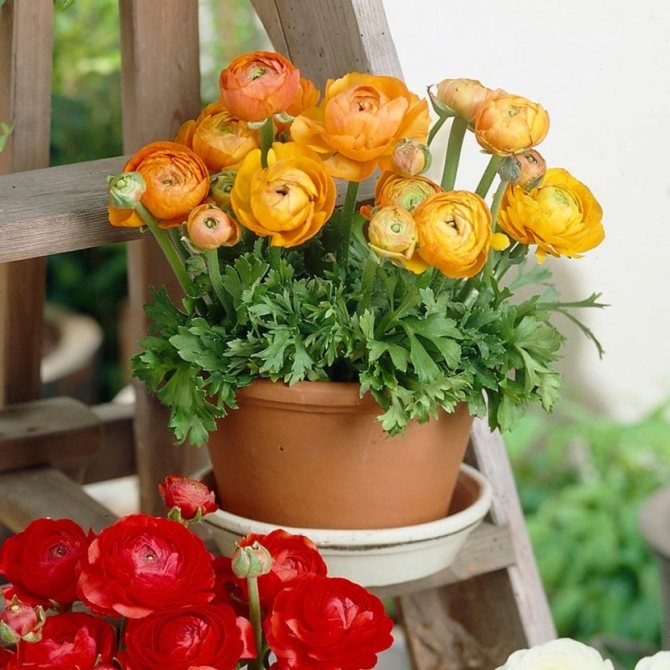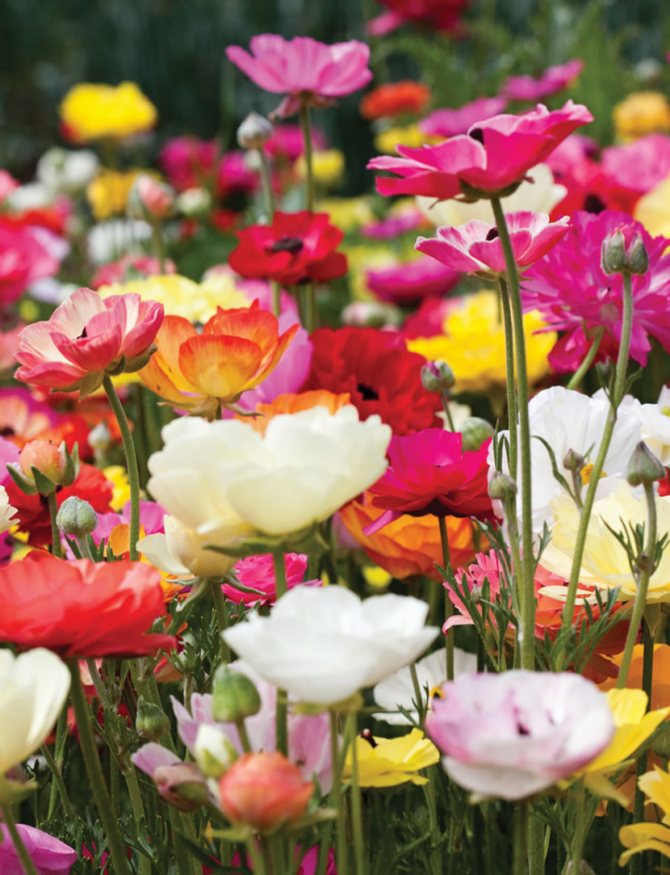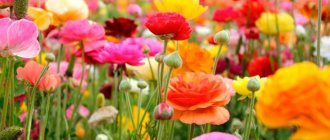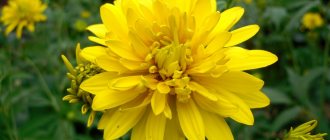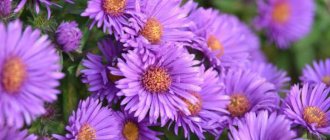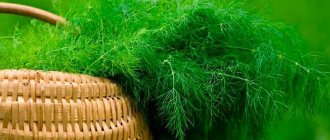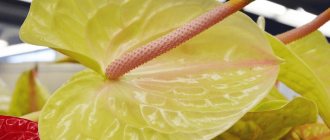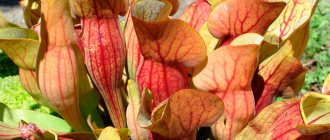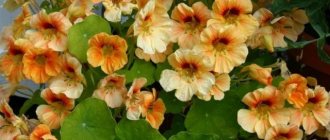Maybe this is the first time you hear about a plant called ranunculus... But still, most growers are very familiar with him. This plant has a simpler name - asiatic buttercup... Unlike most other types of plants, this flower can be grown not only outdoors, but also at home, in a flower pot. Many people are attracted to this plant for its unusual flowers. They look great. It is this fact that explains the fact that ranunculus was able to gain its wide distribution as a beautiful decorative element in the house. In addition, it is often used to create beautiful flower arrangements and bouquets. But still, this plant must be used carefully, since it is poisonous. The ranunculus juice contains a large number of toxic substances. If they act on a person for a long time, then this can lead to severe poisoning. But still, otherwise, there will be no other problems with this plant, since it is quite simple to grow and care for it. The most important thing is to study some of the nuances of carrying out these works. If you want to get acquainted with such a plant as ranunculus, then in this article you can do it. Here you will learn how planting should be done and how to care outdoors. Also, it is here that you can find a photo of this plant.
How to grow an Asian buttercup
In the event that you decide to grow ranunculus, then first of all you will need to choose a method of breeding it.
Description
In the 16th century, the plant was brought to England and immediately won the love of flower growers. However, after a while, the popularity of buttercup dropped noticeably. Today ranunculus is popular again.
Plant height can reach 30 cm. It has a large root system, powerful stems and strongly dissected leaves. On these grounds, ranunculus resembles a dahlia. Flowers bloom one after another throughout the summer, starting in late spring. Their diameter can reach 10 cm. The flower itself can be externally compared to a peony, rose or terry poppy. Flowers can be double or double. The colors of the inflorescences are very diverse. There are no blue and blue shades of buttercup.
Interesting! Pink and white ranunculus look especially gentle and elegant. The decorative qualities have led brides to include plants in their wedding bouquets.
Photos of ranunculus
Views
Today, there are about 600 varieties of culture. The following varieties are popular in floriculture:
- Peony is a spectacular variety of the garden buttercup. It stands out with large double flowers. The coloration of the peony ranunculus is varied: red, yellow, white, pink, purple;
- French is another type of buttercup with bright, semi-double inflorescences. Basically, the color of the variety is yellow, but varieties of other shades are bred;
- Persian is a delicate and showy variety of ranunculus. Flowers can be double or simple. Stems are low;
- Turtle-shaped - buttercup, which is also called African. The flowers are large, densely double, almost spherical. Various colors.Flowers can be visually compared to roses or peonies.
By combining different varieties and colors of these charming plants, you get delicate and elegant bouquets for weddings.
Garden buttercup, its varieties
Ranunculus garden is a bred plant by selection from the Asiatic buttercup:
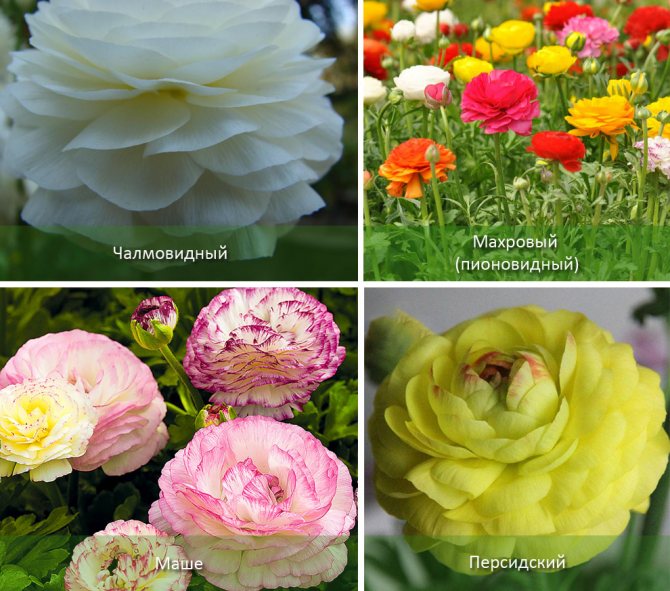
| Varieties | Description | Flowers |
| Masha | Small branched plant up to 40 cm tall, with feathery leaves. | Terry in various shades, including white and pink. |
| Terry (peony) | One of the most beautiful among buttercups, it is called the "flower of the bride". | Large terry in various shades, including purple. |
| French | As the name implies, it was obtained by breeders in Europe. | Semi-double in various shades. |
| Persian | Up to 40 cm high, the leaves are pinnate. | Semi-double averages. |
| Chalmoid | Leaves are slightly dissected. | Large spherical, petals curled inward. |
Where is it grown?
The garden buttercup is suitable for growing both in the garden and at home. Most often, plants are planted in flower beds or on verandas and balconies.
In the conditions of central Russia, buttercup is a rather capricious culture. In the open field, it is most likely that it will not be possible to protect the plant from winter frosts, so some people prefer to bring the culture into the house for the winter. However, to date, most flower growers have begun to grow annual varieties, acquiring new tubers every year.
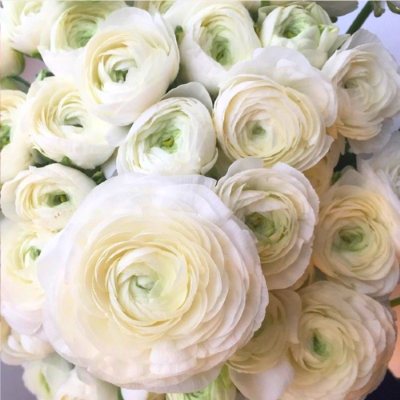

Ranunculus peony
Ranunculus grow well in indoor conditions. However, according to experienced florists, it is better to plant the plants not one at a time, but several. In general, home and garden care is not much different. Both at home and on the street, the buttercup grows well and pleases with its colorful flowering.
How to care for your garden ranunculus
Planting and caring for ranunculus is not particularly difficult. The plant does not like excessive soil moisture, so watering should be moderate. But the regularity must be observed. If mold appears on the leaves or buds fall, you should try to reduce the amount of watering.
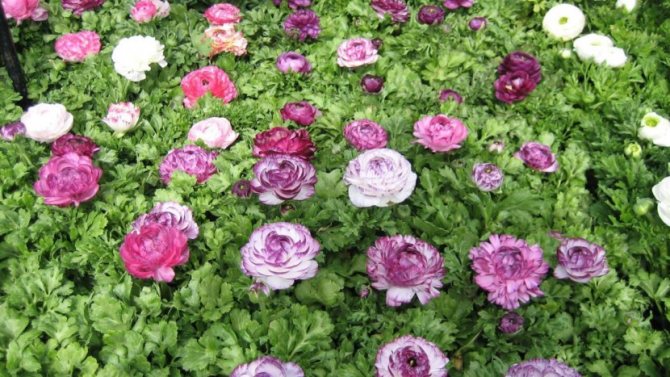

In this case, the soil near the flower must be loosened, after removing the dead plant elements. If the inflorescences have already completed the flowering period, then they must be promptly removed.
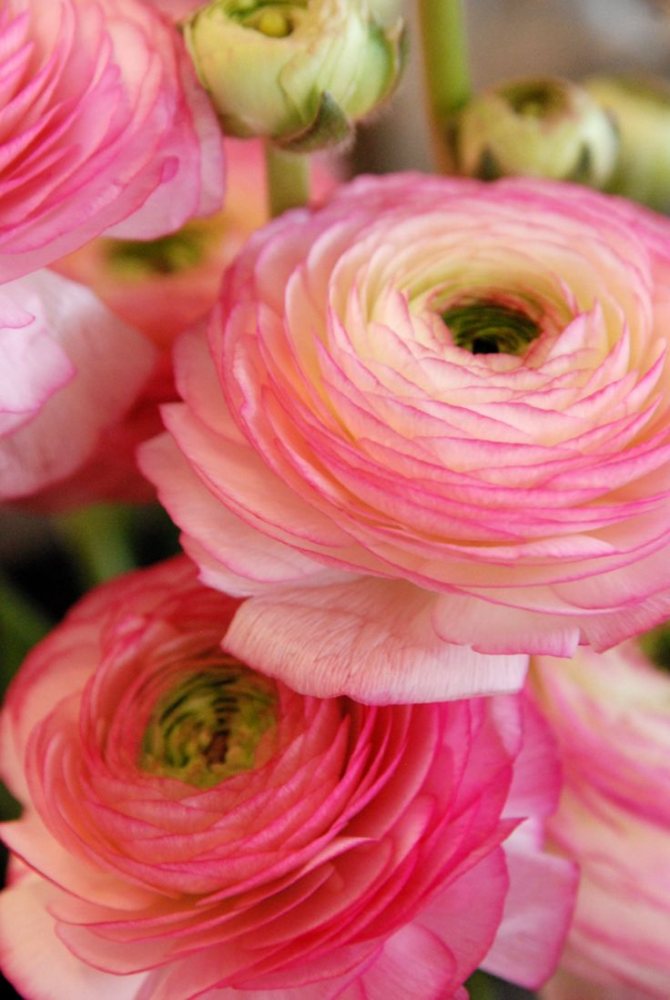

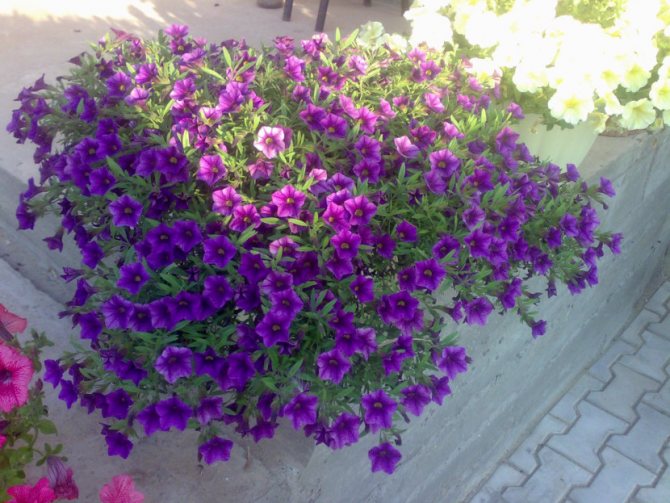

Bacopa - description of the species, cultivation, care, reproduction + 74 photos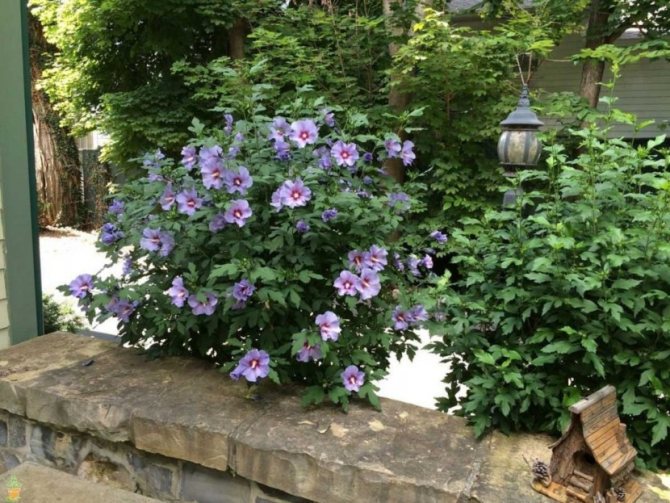

Garden hibiscus - types, description, planting, care and reproduction + 69 photos
- Celosia - growing from seeds and seedlings, planting in the ground and care rules + 80 photos
Potash fertilizers are used for feeding - potassium salt, potassium sulfate or ash. During flowering, 45-50 g is applied to an area of 1 m2 at intervals of 1 time in 14 days.
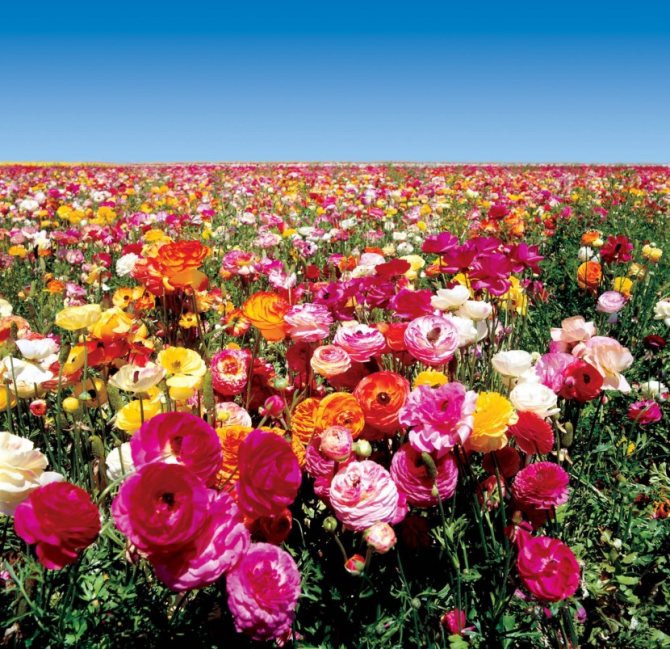

The plant is susceptible to spider mites. Damage by aphids and thrips is also dangerous. If silvery or light spots appear, it is necessary to promptly treat with an insecticide.
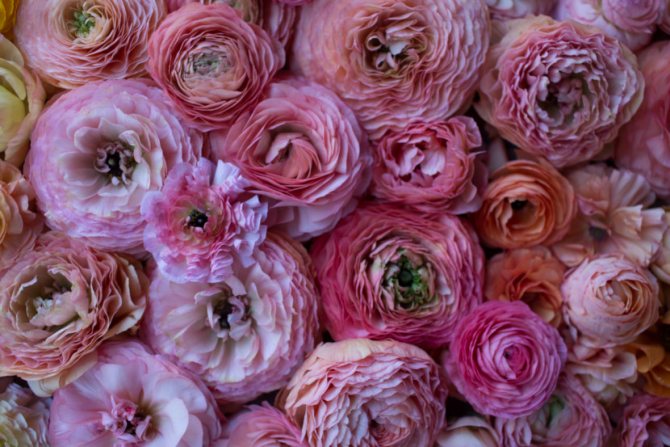

Spraying with 0.2% mercaptofs solution 2-3 times weekly is effective as a prophylaxis.
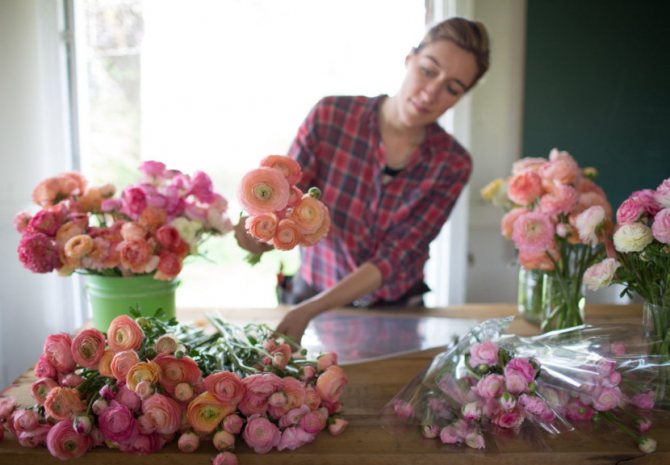

Care features
Ranunculus is a very unpretentious plant, however, caring for it has a number of features that must be observed.
Soil and planting site
First of all, you need to know where to plant ranunculus and what soil to choose for this. The soil for planting a plant should be nutritious and light. The reaction is neutral.
Helpful! If the soil is acidic, then you need to add chalk or limestone to neutralize the acidity.
Buttercup does not tolerate waterlogging and moisture retention in the soil. Therefore, it is recommended to choose a water-permeable and breathable substrate. Ideally, it is desirable to provide a good quality drainage layer. Ordinary sand is suitable for drainage. Before planting ranunculus, it is recommended to dig up the soil by adding a little compost to it.
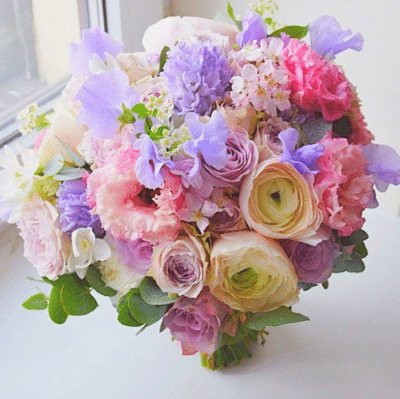

Ranunculus purple
If you decide to plant a buttercup at home, then the rules are not much different. A light and nutritious soil is recommended. It should be based on peat. It is recommended to put good drainage at the bottom of the pot. It can be brick chips, fine expanded clay or the same sand. The container for planting ranunculus should be wide and spacious.
It is recommended to plant a buttercup in a sun-lit area or in partial shade. Penumbra is a preferred place. Firstly, the color of flowers in partial shade will be more intense, and secondly, the plant will bloom a little longer. At home, it is recommended to put boxes with flowers on the south window, where there is more light than on other windows. But the east or west side will also work.
Important! It is recommended to plant ranunculus after the threat of frost has disappeared.
Watering
The plant needs regular watering. However, it is not recommended to use too much water for irrigation, since ranunculus does not tolerate excess moisture in the soil. This can lead to decay of the root system.
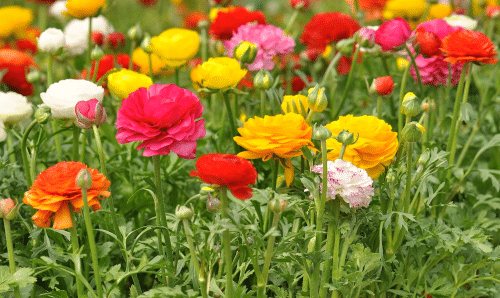

Ranunculus in the garden
After watering, it is recommended to loosen the soil and remove it from weeds. It is recommended to use soft water for watering.
Fertilization
The plant responds well to top dressing. Ranunculus prefers potash fertilizers. Fertilizers such as wood ash, potassium sulfate are especially good. Fertilizers are also necessary when growing a buttercup in indoor or balcony conditions. Fertilization is required closer to flowering and throughout the flowering period.
Storing tubers in winter
For the winter, the tubers are dug out of the soil to prevent them from freezing. It is required to store tubers in a dry and dark room.
It is recommended to dig up the tubers at the end of summer after flowering. Then the tubers are soaked in a solution of potassium permanganate, after which they are dried at a temperature of about 20 degrees. Tubers need to be stored in paper wrappers, while small tubers can be stored in sawdust or sand.
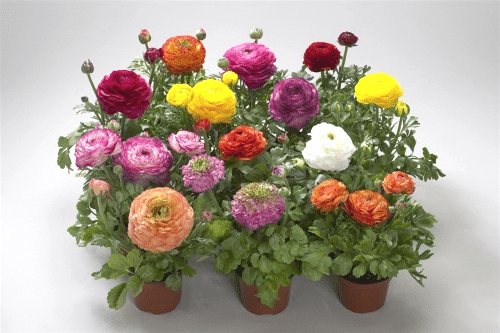

Ranunculus in a pot
If ranunculus grows in the southern region, then it is not necessary to dig up the tubers. It is enough to cover the plant for the winter with spruce branches or sawdust. However, when the temperature drops to -10, tubers are likely to freeze.
Important! Be careful when digging up the tubers - the roots are very fragile and can be damaged if handled carelessly.
Stimulating flowering
For buttercups to bloom better, you must:
- Provide them with conditions with plenty of sunlight and a little shading at noon;
- It is recommended to cut off faded inflorescences;
- It is imperative to apply potash dressings at the beginning of flowering and during the entire flowering period;
- When growing indoors in hot weather, it is recommended to take the pots out to the veranda or balcony;
- Spray crops periodically, especially when growing at home.
Such simple rules will help to grow beautiful and healthy ranunculus, which will enchant with their double flowers with a rich color and long flowering.
Buttercup care outdoors
Although buttercups are unpretentious, like any other garden flowers, they require care. Ranunculus grows on wet soils, therefore, loves water. But with excessive watering, it can die, or mold will appear on its roots. Also, do not let the soil dry out. After flowering, watering should be reduced.
In order for oxygen to reach the roots, the earth is periodically loosened around them and the wilted parts are removed in order to direct the nutrients to the fresh flowers.
While the leaves are gaining green mass, buttercups are fed every 2 weeks with nitrogen fertilizers. And during flowering with the same frequency of phosphorus and potassium.
If the plant has grown too much, remove excess shoots.
Pruning
Pruning buttercups is carried out in the fall after the complete withering away of the aerial part of the plant. The peduncles are cut off completely, leaving slightly above the ground.
Storing tubers
At the end of summer, when the stalks and leaves of ranunculus wilted, they are dug out of the ground, the remaining soil is removed from the tubers, treated against diseases and rot and laid for storage.
One of the ways: the rhizomes are laid out in cardboard boxes or paper bags, then sent to a cool room for the winter, where the temperature does not drop below +4 ° C.
Another way: sand storage. The sand is dried, poured into boxes or boxes and the bulbs are put there.
Pests, diseases
Like other crops, buttercups are susceptible to disease and pests.
Among the diseases, various types of rot are most often found. The reason is waterlogging of the soil. Therefore, it is strongly recommended not to overflow the plant. If the culture begins to rot, then it is necessary to reduce the amount of water or, if possible, transplant the plant to another place, removing the damaged roots.
Common pests:
- Spider mite;
- Aphid;
- Thrips.
The fight against them is required to be carried out with the help of insecticidal and acaricidal preparations. For prevention, it is recommended to treat ranunculus with mercaptophos.
Acaricidal agent
Possible threats
Diseases and pests:
- nematodes. Rhizomes are affected and exist at the expense of living plant juices, breed under conditions of excessive watering in summer heat. Difficult development of ranunculus, foliage twisting are noted. Plants are dug out of the soil, the rhizomes are cleaned of soil residues - they can be distinguished by rounded lesion zones. The roots are immersed in a bucket of hot water for five minutes, but not warmer than fifty degrees. The contaminated soil is subjected to antiparasitic treatment, the plant is dug in again. An alternative is a five-day treatment of ranunculi with "Mercaptophos", three times in a daily interval;
- spider mite. There are yellowish or ash-colored spots on the leaf plates on top, and whitish specks on the underside. Damaged foliage must be removed, the plant is subjected to insecticidal treatment;
- mold rot. It develops in conditions of excessive watering or unreliable drainage, when the liquid is retained in the near-root zone of the soil. A whitish bloom is noted on the leaf blades, the buds dry out. To eliminate the disease, the leaves are cut with a pruner, the cuts are moistened with a fungicide solution. The soil is loosened, the volume of irrigation is reduced;
- aphid. There are spots, damage on the leaves. Affected leaf plates are pruned, the plants are sprayed with an insecticidal preparation such as "Biotlin".
Activities related to digging up a flower threaten with unpredictable consequences. The viability of the Asiatic buttercup weakens during transplantation and manipulation of tubers during the active life cycle.
Before the flowering period, preventive treatment of ranunculus is organized, for spraying water is used with dissolved caustic soda in a half-percent con, diluted in a ratio of seventy-eighty grams per ten-liter bucket.
The Asian buttercup is an adornment of the garden economy and an aid in decorating and drawing up picturesque bouquets. Elementary floriculture skills and the correct organization of the site are required to grow ranunculus in flower beds. Tuberous planting of these flowers gives the fastest and most impressive results.
Reproduction
Ranunculus propagates by the following methods:
- Seed;
- Tuberous.
To propagate a culture by seeds, you will need:
- Seeds are sown at the end of winter in a light substrate, sprinkling them with a layer of substrate no more than 2 cm;
- It is recommended to cover the crops on top with plastic wrap to create a greenhouse effect;
- It is required to keep crops at a temperature of about 16 degrees in a bright place;
- Periodically, the film needs to be slightly opened to moisten the substrate;
- After the first shoots appear, it is necessary to completely remove the film;
- When two pairs of leaves appear on the seedlings, they must be dived into individual containers;
- When the threat of frost disappears, it is time to plant the seedlings in open ground.
Important! Ranunculus seeds are characterized by low germination.
For reproduction by tubers you will need:
- Only healthy and large tubers are used;
- The tubers are carefully divided so that each has several buds;
- Tubers are planted in the ground when warm weather is established;
- It is recommended to soak the tubers in a potassium permanganate solution before planting. Plain cold water will also work;
- It is recommended to lay the bulbs in the planting holes with the roots down to a depth of no more than 8 cm;
- It is recommended to maintain a distance of about 13 cm between the bulbs.
This method of reproduction is preferable to seed.
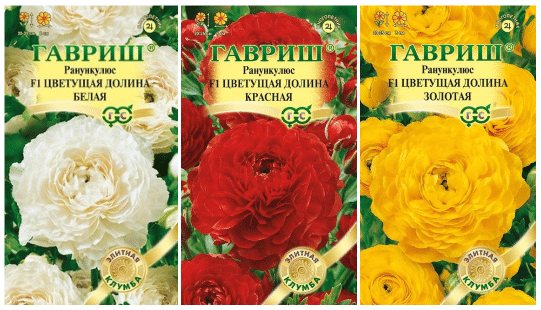

Ranunculus seeds
How to plant
The swollen nodules are buried in the soil by about 5 cm. At the same time, care must be taken to ensure that the "spider's legs" are at the bottom. Otherwise, buttercups may not germinate. The distance between individual plants should be at least 10 cm. Buttercups should be planted in moist soil. After the nodules are buried in the ground, the flower bed can be watered a little (but not too abundantly).
Buttercups sprout about a week and a half after planting. They bloom in 2.5 months. By the end of August, manynuts ripen. Each of them contains about 500 small seeds.
Preparing for winter
Buttercup is not the most hardy plant. If climatic conditions allow, then it is enough to cover the bush with spruce branches or dry leaves. You can additionally insulate the flower in winter by throwing snow on it.
Popular: Three Ways to Grow Blooming Bobo Hydrangea Paniculata
In a harsh winter, gardeners recommend digging up the rhizomes and storing them at home. The flower does not tolerate such manipulations. The plant may grow weaker the next year. If the climatic conditions are harsh, then the option is to buy new planting material, for example, the Kashubian buttercup variety.
Preventive measures
Attention should be paid to children, since they are characterized by active knowledge of the world through the plucking of plants that can potentially be life-threatening. And it doesn't matter whether you are walking in the forest or not, a poisonous buttercup can be found everywhere.
When going into the countryside far from the nearest hospital, you should take a first aid kit with you, which contains first aid supplies.


It is worth explaining to children that they should not eat any berries, leaves, stems they encounter without the permission of an adult.
If you need a poisonous buttercup as a means of traditional medicine, study its description so as not to be confused with other plants. Also, be sure to consult with your doctor, especially regarding the recipe for preparation, dosage, and whether you have any possible contraindications. You need to collect plants with rubber gloves, preferably in closed clothes and glasses.
When collecting any medicinal plants, you should first study their description in the botanical atlas. It would be even better to buy ready-made forms at the pharmacy or go to the preparation with an experienced person.
You should not collect bouquets from plant flowers. In confined spaces, their presence can lead to headaches, allergies, and poisoning in weakened or elderly people.
Care during and after flowering
Half-open buds resemble a rose, fully blossomed like a lush poppy. To compose bouquets, not only white, cream and pink inflorescences are increasingly used, but also varieties with a more saturated color of the petals.
On a note:
- The spectacular bloom begins at the end of May and continues throughout the summer.During this period, the plants are slightly shaded: this way the buds will last longer, the site will look spectacular for more than three months.
- Faded buds are removed so that the plant does not waste juices in vain: use a sharp knife. If you leave wilted buds on the stem, then new inflorescences appear in smaller quantities. If there are a lot of faded elements on the bush, then you can not wait for new buds.
- At the end of the flowering period, the seeds are collected, at the end of August, the stems are cut almost to the root.
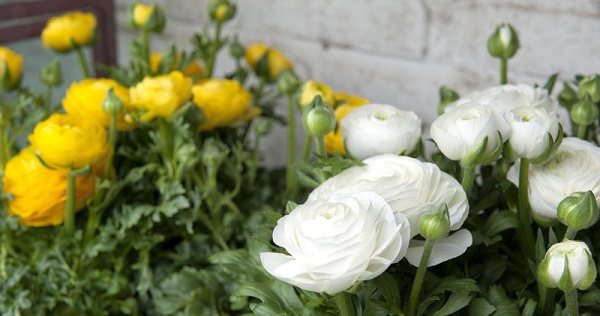

Mulching, loosening, other agrotechnical measures
In addition to the basic types of care (watering, fertilization, illumination, temperature), there are several rules that are useful to follow:
- after planting the seedlings, mulching is carried out using finely chopped straw. A simple type of work reduces the growth rate of weeds, retains moisture;
- loosening is an agrotechnical measure, without which the soil surface is compacted, the quality of aeration of the substrate decreases. Loosen the soil carefully and shallowly to preserve the integrity of the underground part;
- weed control. It is important to pull out varietal grasses in time so that they do not "hammer" young and adult beautifully flowering plants. The first weeding is carried out while the seedlings are not very high, otherwise the growth of the Asiatic buttercup is significantly reduced: the weeds take nutrients from the soil and fewer useful components remain for the flowers.
Important! Adult flowers do not like transplanting: you need to immediately decide on a suitable site so as not to disturb the ranunculus.
Storage of tubers (wintering)
At the end of the flowering of buttercups, the frequency of watering is reduced, and with the yellowing of the leaves, it completely stops. The plant does not tolerate sub-zero temperatures (it dies at -7 ° C), therefore, it is dug up in August-September. It is important to carry out the procedure immediately after the foliage dies off, otherwise the flower may give young shoots, which is highly undesirable.
After digging, the tubers are washed, examined for pests and diseases. Cleaning from the ground is done carefully so as not to damage the thin roots.
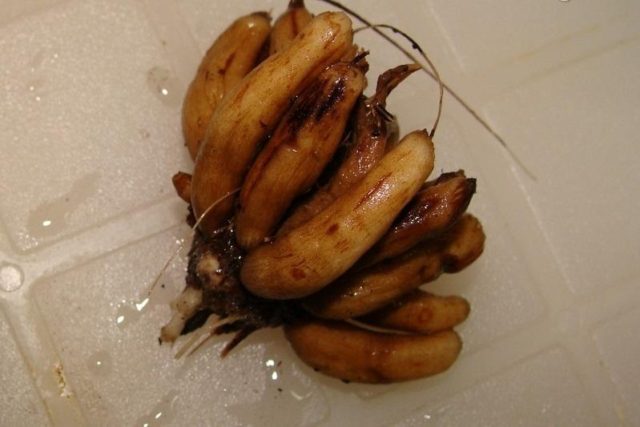

At this stage, the reproduction of ranunculus by tubers is carried out - it is enough just to divide the nests that have grown over the summer into parts. So, one bush per season is capable of producing up to 5-7 children.
To exclude the appearance of pests, the separated tubers are treated with a solution, which includes any fungicide. Storage is carried out in peat or sand at a temperature of +4 +5 ° C. There is also an alternative wintering option for buttercup - the flower tubers are dried for 3 weeks to the state of a crouton, and stored until spring in a dry place at room temperature.
Note! In winter, the future planting material is periodically examined for the development of fungal diseases. If found, the tuber is treated with brilliant green or colloidal sulfur. If the lesion is large, the plant is removed to avoid further contamination of healthy roots.
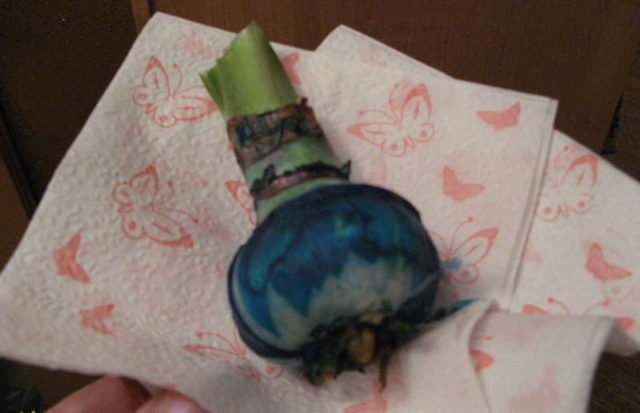

The garden buttercups shown in the photo will retain an attractive appearance only if replaced periodically. After 3-4 years, they lose their decorative properties and immunity to viruses. therefore it is recommended to do a new seeding in advance.
What the garden flower is sick with
Such ornamental plants are practically not affected by diseases. But if the summer is too wet, then powdery mildew may appear on it. Less commonly, the bush is affected by the cabbage butterfly or nematodes.
When infected with nematodes, the flower does not grow well, its leaves curl. The gardener should pull the bush out of the ground, remove the soil from the roots and rinse them in warm water. Its temperature should be no more than 55 degrees. Treatment with insecticidal agents helps from the rest of the insects.
Growing from seeds
Flower reproduction occurs by dividing the root or sowing seeds. Choosing the second method, you should give preference to ready-made planting material, which is sold in specialized stores. Seeds harvested by hand do not pay off labor costs due to poor germination.


Seeding is done at the end of the last winter month or early March. The soil should be loose, its composition: one part of peat and leaf land, 0.5 parts of sand. The sown seeds are sprinkled with a layer of soil, then moistened with a spray bottle. The container is covered with glass and placed in a room with a temperature of 10-12 ° C. Airing is carried out regularly, condensation is removed from the glass.
After 2-3 weeks, shoots will appear, from this moment the container moves to a warm place with an average temperature of 20 ° C. A south-facing window will work well, shading from direct sunlight will do the trick. Additional lighting can be arranged if necessary. When 4-5 true leaves are formed, planting is carried out in peat-humus pots.
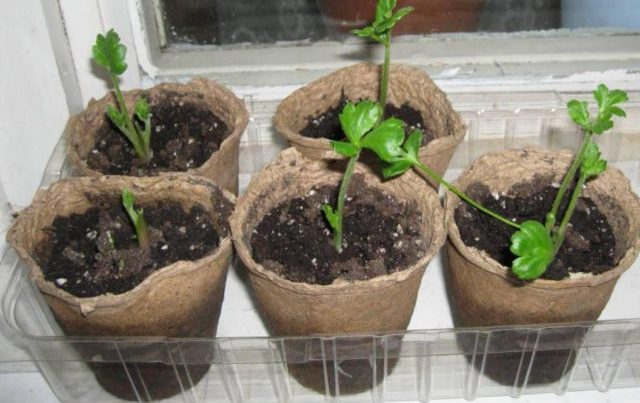

Fertilizing and feeding buttercup
If you want your garden buttercups to grow healthy, bloom profusely and beautifully, then you need to feed them periodically. During the period of leaf growth, these perennials must be fed with special fertilizers rich in nitrogen. When buttercups begin to appear in buds, they need phosphorus-potassium fertilizer. Top dressing is best done once every two weeks. These simple procedures will provide your buttercups with amazing growth and flowering.
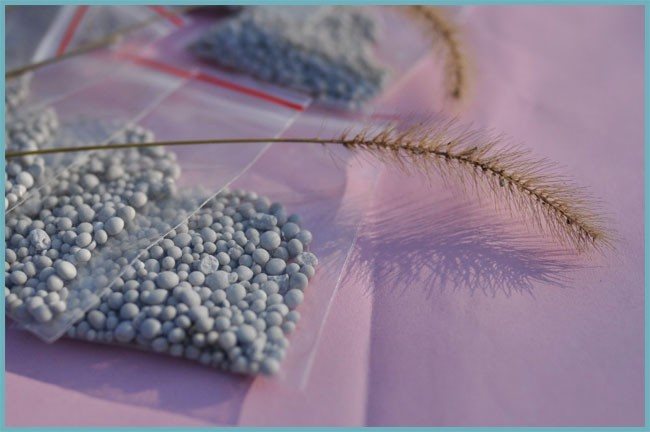

Buttercups need mineral feeding at all stages of the growing season
Application in traditional medicine
As a medicine, creeping buttercup has been used for a long time. In folk medicine, there are many different recipes when the use of this plant helps to cure certain diseases. The substances that make up the buttercup, which are irritating when applied topically, in small doses can increase the number of red blood cells in the blood, stimulate the activity of the nervous system, have an antimicrobial effect, ridding the body of the pathogens of staphylococcus and Escherichia coli.
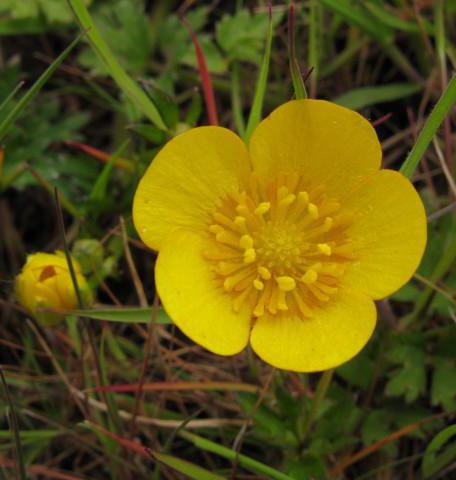

The bactericidal, wound healing and analgesic effect of buttercup has long been used to treat gout, rheumatism, sciatica and arthritis. Buttercup creeping is very effective against skin diseases. The gruel made from the leaves of this plant successfully treats fungal skin diseases, scabies and warts. Powdered leaves and flowers were used in the old days instead of mustard plasters, and also applied to abscesses and boils, which accelerated their ripening.
When using buttercup as a medicine, do not forget that this is a poisonous plant, and therefore it is necessary to avoid getting its juice on wounds, scratches and cuts.
Poisonous properties
Buttercup creeping, the description of which is given above, belongs to the category of poisonous plants. Moreover, all of its parts are such. This is due to the high content of esters, protoanemonin, ranunculin and flavonoids in them. These substances can have a damaging effect on the heart, digestive organs and kidneys, and excite the nervous system.
Avoid getting the juice of the plant inside - this can cause a burning sensation in the mouth and stomach. The result is vomiting, profuse salivation, and abdominal pain. Sometimes, in especially severe cases, poisoning with buttercup poison leads to seizures and loss of consciousness. Even getting juice on the skin often leads to burns.
Content
- Listen to the article
- Description
- Growing buttercups from seeds
- Planting buttercups in the garden When to plant
- How to plant
- How to grow
- Ranunculus aconitifolius (Ranunculus aconitifolius)
Main characteristic
Belongs to the Buttercup family, the genus has about 600 species, among which there are wild specimens. Getting rid of them is quite problematic. But cultivated species can become a real decoration of a flower garden.
In the second half of the 17th century, gardeners and botanists became interested in buttercups, and this became a new page for the plant. From this period, the garden buttercup began to be grown in culture and is gaining more and more popularity.
Botanical description
- Buttercup Garden or Ranunculus is a perennial plant that was bred by breeders, and the northern countries are considered their homeland. The prefix "rana" means "frog". And indeed, buttercup is very fond of moisture and warmth. Many species in the wild grow near water bodies.
- Buttercup Garden is also called Asiatic Buttercup. It is one of the most popular types in floriculture.
- Buttercups that grow naturally have smaller flowers. All representatives of the genus have poison in the stems and leaves of the plant. Therefore, if there are children, then it is not recommended to plant a buttercup on the site.
- It is a shrub whose height varies from 40 cm to 1 m.
- The stem of the plant is straight, simple in structure, sometimes has a slight branching.
- The root system is presented in the form of a tuber. The leaves are three-part in structure. A distinctive feature is a rather strong pubescence.
- The flowers are medium, with a circumference of about 10 cm. The color palette is very diverse, except for shades of blue and light blue. Some varieties are represented by single flowers, some flowers are collected in small inflorescences.
- The structure of flowers is terry or semi-double. The petals of the buds are slightly bent. The decorativeness of buttercups lasts for 3 - 4 years, then the bushes need to be updated.
Known species
Conventionally, there is a classification that is convenient to use.
- Asian (garden). Most often grown. The main advantage is terry lush flowers, reminiscent of roses.
- African. The structure of the flower is similar to the structure of a peony flower - the upper parts of the petals are slightly bent inward. The leaves are dark green and rather large in size.
- Caustic. This specimen is more often seen in the wild. Its color is yellowish with gold. Usually used as a medicinal plant.
- Aconitoliferous. Plant height is not less than 0.80 m. Flowers are often white, sometimes yellow.
- Anemous. A miniature plant in the form of a bush no more than 30 cm high.
- Multi-flowered. Perennial, the flowering period lasts throughout the summer. The flowers are bright and lemon-yellow, the height of the bush is about 50 cm.
Popular varieties
There are a lot of them, so we will consider only the most famous ones. The seeds of these varieties can be purchased in various online stores and in regular flower shops.
Pink
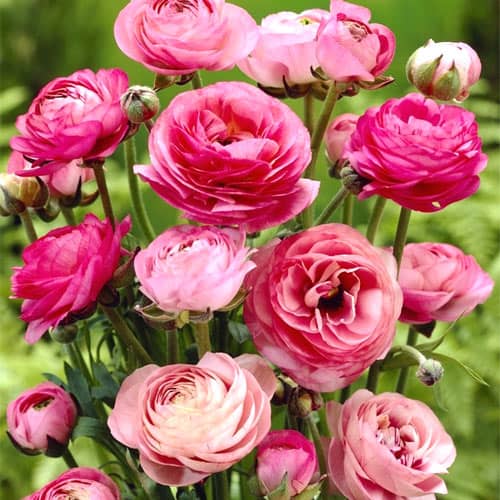

- This variety is often used in wedding bouquets. Delicate pink petals are collected in a lush inflorescence. The shape is reminiscent of peonies or roses. The circumference of the flower is from 4 cm to 6 cm.
- The height of the bush is 30 - 40 cm. The plant is grown not only in open soil, but also as a pot culture, as well as on terraces, balconies and loggias.
- A very frost-resistant variety (withstands up to - 30), takes root well and retains a fresh look in the cut for up to 2 weeks.
Bloomingdale Rose Bicolor
- An excellent variety with white double flowers with bright pink blotches. Bicolor colors are very original and are used with pleasure by flower growers to decorate flower beds. The diameter of the flower is about 10 cm. The height of the bush is only 20 - 25 cm, it is considered dwarf.
- The stems are small, but strong, the leaves are dissected, openwork, which adds spectacularity to the flower.
Pearl Pikoti
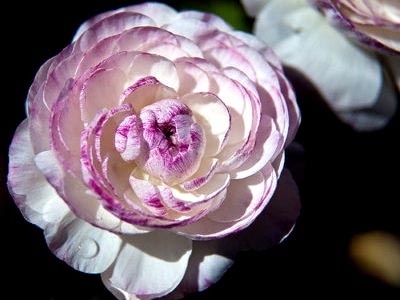

The highlight of this ranunculus is the contrasting colors, consisting of several tones: the main color is white, and the petals are painted in a lilac shade at the edges.
Yellow
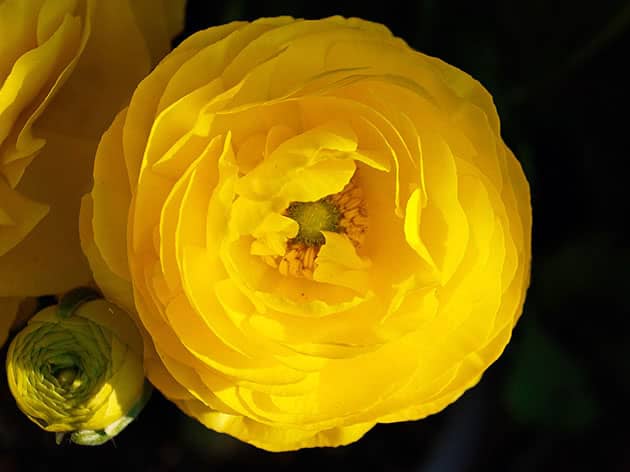

Plant height 20 -25 cm. The variety has an average resistance to cold weather, severe frosts and temperature changes. Buttercup garden of this variety blooms from July to August. If you cut the flowers for a bouquet, they can stand for 2 weeks in excellent condition.
Ranunculus Asiatic Red
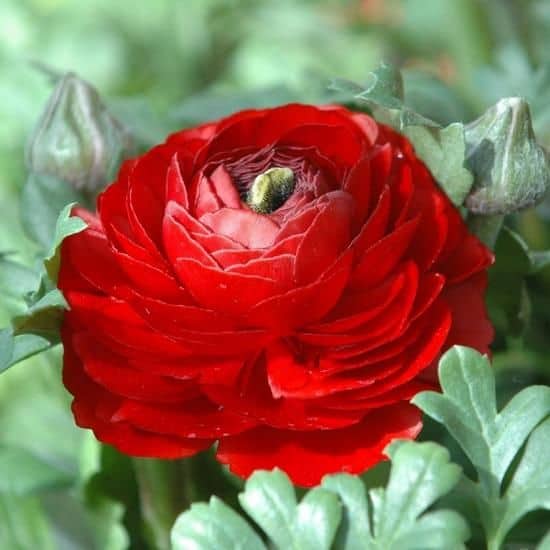

Bright red double petals make this variety one of the most aristocratic and stylish. Pale green leaves set off bright inflorescences favorably.
This is just a small part of all the varieties that are very beautiful all, each in its own way. To grow such beauty in your country house, you need to know the rules and follow the basic recommendations for planting and care.


